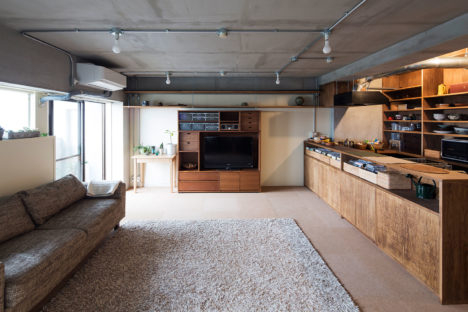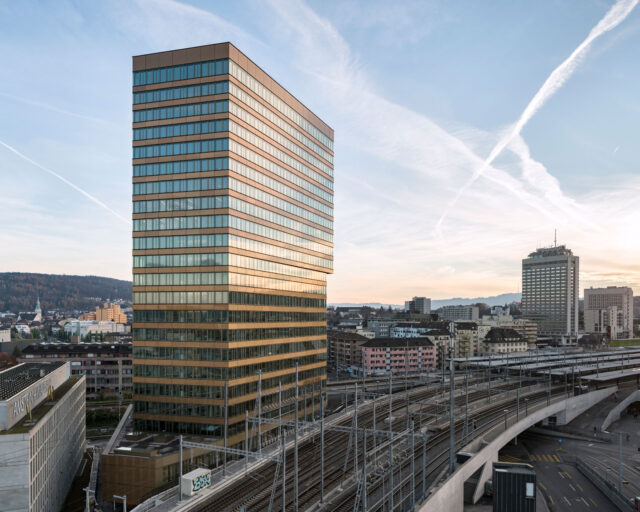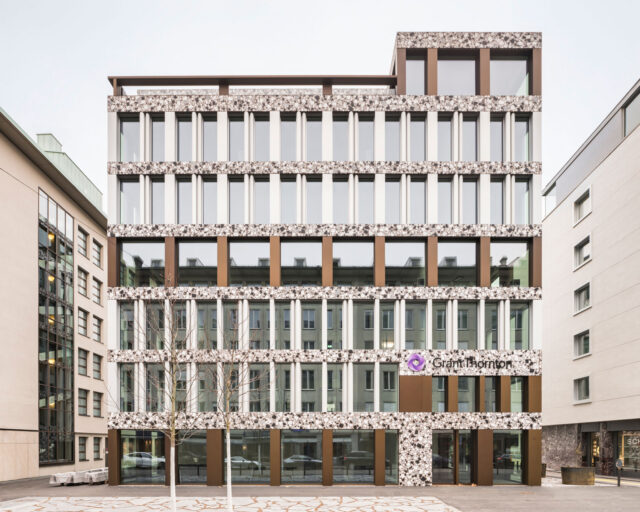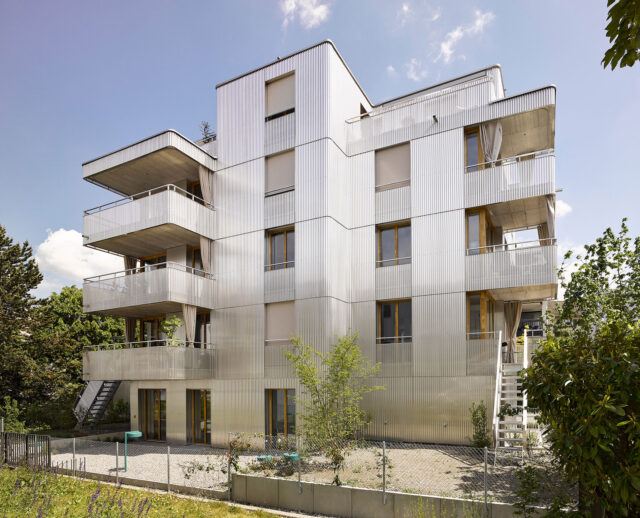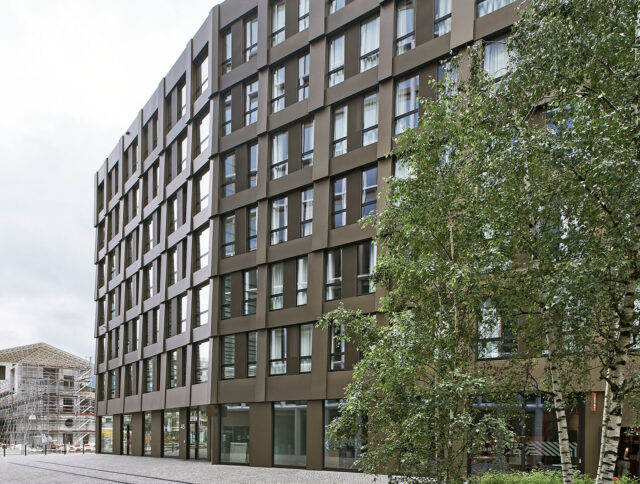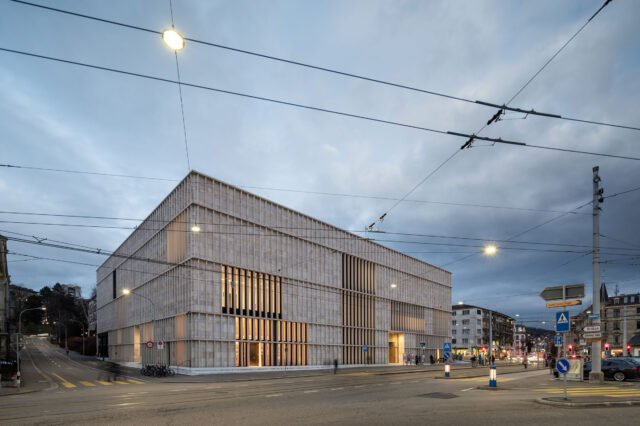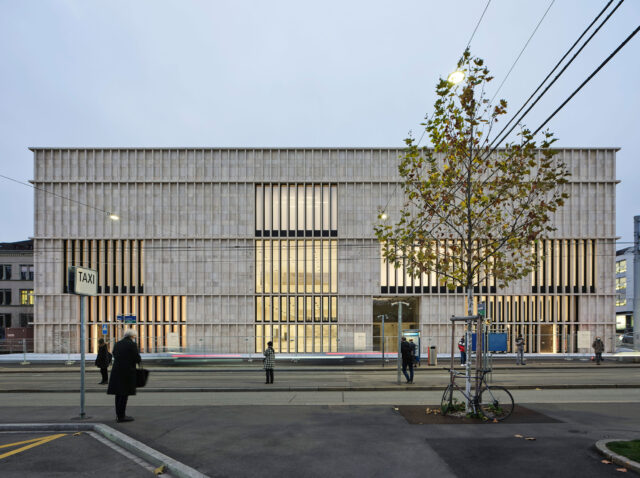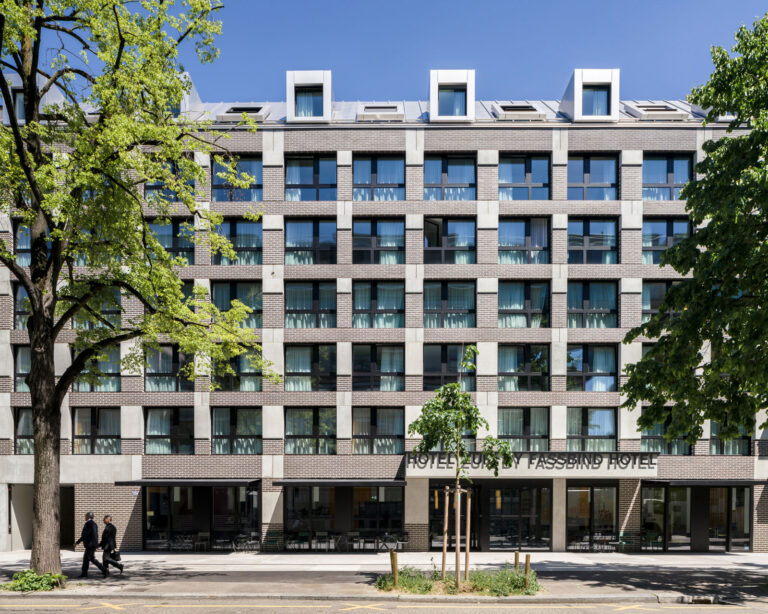
SHARE ギゴン / ゴヤーによる、スイス・チューリッヒの宿泊施設「ホテル・ツーリ・バイ・ファスビント」。1980年代に建てられた施設の改修で躯体を残し刷新、ファサードには地域の特徴的な素材“クリンカーレンガ”を使用、内部空間でも使用者の体験を重視した採光と素材選択を丁寧に行う



ギゴン / ゴヤーが設計した、スイス・チューリッヒの宿泊施設「ホテル・ツーリ・バイ・ファスビント」。1980年代に建てられた施設の改修で躯体を残し刷新、ファサードには地域の特徴的な素材“クリンカーレンガ”を使用、内部空間でも使用者の体験を重視した採光と素材選択を丁寧に行われました。施設の公式サイトはこちら。
こちらは建築家によるテキストの翻訳
ホテル「セネター」は1980年代に建設され、チューリッヒ・ウェストの旧工業地区にある19世紀末の外周ブロック開発に組み込まれたものです。このホテルは、新しい「ホテル・ツーリ・バイ・ファスビント(Hotel Züri by Fassbind)」に生まれ変わりました。幸いなことに、床スラブやコンクリートの仕切り壁などの基本構造はほぼそのまま残すことができました。新しい建物を建てると、用途地域の規制で小型化され、更に多くのエネルギーを消費することになるからです。
屋根とファサードは全面的に作り直しました。この地区の住宅や工場の特徴として、クリンカーレンガ(clinker bricks)というレンガがあります。ホテルのファサードには、このクリンカーレンガが「インタルジア(象嵌技術)」と呼ばれる形で、自立するコンクリート部材の中に鋳込まれています。バスルームを含む館内の備品や調度品はすべて交換しました。外観だけでなく内部も、昼と夜、光と闇、横たわるものと立つもの、抑制された素材色と強いスペクトル色など、対照的なペアで特徴づけられています。
このため、道路前面では濃い茶色のレンガがプレハブ部材に埋め込まれ、中庭ではベージュのレンガが使われています。上部の垂直材と側面の水平材には、それぞれ異なる大きさのコンクリートヘッドが取り付けられ、モジュール構造を示しています。ピアやまぐさの一部もすべてコンクリートでできており、エントランスにある重厚なキャノピーもそうです。中庭に続く通路では、深さ4cmのクリンカーレンガを型枠に固定するために鋳型を使用し、レンガを入れずに打設しています。
ゆったりとした大きさの壁面開口部には、ダークオークの無垢材をフレームとしたフルハイトの木材と金属製の窓が設置されています。新しい二重勾配屋根の部屋に光を供給するため、ステンレス鋼の屋根はドーマーと屋根窓で交互に貫かれています。中庭棟の各コーナーには、2つのドーマーが並んで配置され、アクセントとなっています。また、内部では「昼光灯籠」によって、テントのようなコーナールームをより一層引き立てています。
ホテルのベッドルームの造作家具は、明暗のあるオーク材を使用しています。大きな鏡がゲストを空間へと導き、空間を広げます。また、部屋から街に向かって開かれた窓も同様です。布張りのベンチは、座椅子としても荷物置きとしても使えます。グレーベージュのカーペットに織り込まれた文字は、英語、フランス語、イタリア語、ドイツ語で「Good day / good night」を告げています。壁面には、この部屋のために特別にデザインされたLEDウォールランプとフロアランプの人工照明を配し、部屋の明るさを調整するカラーパッチが施されています。
また、ホテルの廊下は、大きなランプとカラーパッチによって強調され、視覚的に「短く」なっています。また、スーツケースやランドリーカートから壁を守るために、金属とセメントでできた頑丈なパネルが使われ、足音を抑えるために文字入りのカーペットが敷かれています。地上階には、ロビー、ラウンジ、朝食会場があり、ハインリッヒ通りや市街に面した大きなショーウインドウが空間的な連続性を形成しています。床はファサードと同じクリンカーレンガを使用し、耐久性を持たせています。オーク材と黒いシートメタルでできたレセプションエリアには、壁に沿ってベンチシートが伸び、特注のテーブル、椅子、ペンダントランプが置かれ、ゲストを迎えています。
ハインリッヒ通りには、コンクリート打ちっぱなしの広い前庭があり、半屋外の木陰で朝食を取ることができます。中庭には粗い砂利が敷かれ、鉄筋の大きなプランターが地下駐車場の上に新しく植えられた落葉樹の根を張らせています。
以下の写真はクリックで拡大します














以下、建築家によるテキストです。
The Hotel “Senator” was built in the 1980s and integrated into a late 19th century perimeter block development in the former industrial district of Zürich-West. It has been converted into the new “Hotel Züri by Fassbind”. Fortunately, it was possible to retain the basic structure of floor slabs and concrete partition walls almost unaltered because a new building would have been smaller, as stipulated by zoning regulations, and would have consumed more embodied energy. The roof and the façades were entirely remodelled. One of the characteristics of the district’s residential and factory buildings are clinker bricks, used as facing bricks or as infill in frame structures. On the hotel façade, they take the form of “intarsia” that are cast in self-supporting concrete elements. All of the fittings and furnishings inside the building, including the bathrooms, were replaced. The inner as well as the outer appearance is marked by contrasting pairs such as day and night, light and dark, lying and standing, restrained material colours and strong spectral colours.
Thus, on the street front dark brown bricks have been embedded in the prefabricated elements of the cladding; in the courtyard the bricks are beige. Differently sized concrete “heads” terminate the vertical elements at the top and the horizontal elements at the sides, illustrating the modular construction. Some of the piers and lintels are entirely of concrete – as is the weighty protective canopy at the entrance. The way in which matrices were used to fix the 4 cm deep clinker bricks in the formwork can be seen in the passageway leading to the courtyard, where the matrices were cast without inserting any bricks.
The generously sized wall openings feature full-height timber and metal windows with frames of solid dark oak. To provide light for the new mansard rooms, the stainless steel roof is pierced alternatingly by dormers and roof windows. Two dormers placed by side by side accentuate each corner of the courtyard wing – and, in the interior, enhance the tent-like corner rooms with a “daylight lantern”.
The built-in furniture in the hotel bedrooms is made of oak, both light and dark. Large mirrors guide guests into the space and expand it, as do the windows that open the rooms towards the city. An upholstered bench can be used as both seating and a luggage stand. Letters woven into the grey-beige carpeting wish guests good day/good night in English, French, Italian and German. Patches of colour on the walls modify the daylight in the rooms and, above all, the artificial lighting consisting of LED wall and floor lamps designed especially for these rooms.
Large lamps and patches of colour also accentuate the hotel corridors and “shorten” them visually. Robust metallic and cement-based panelling protects the walls against trolley suitcases and laundry carts, and carpeting, also with lettering, dampens the sound of footsteps.
At ground level, the lobby, lounge and breakfast area form a spatial continuum with large “show windows” facing Heinrichstrasse and the city. Here the durable flooring consists of cast clinker brick fragments of the same kind as used in the façade. Guests are welcomed at a reception area of oak and black sheet metal, with bench seats extending along the walls and custom-made tables, chairs and pendant lamps.
On Heinrichstrasse a generous forecourt in cast concrete invites guests to take their breakfast outdoors under the semi-shade of the trees. In the courtyard the patchwork of paving materials is augmented by coarse gravel, and large tree planters made of steel rebars give newly planted deciduous trees a chance to take root above the underground parking.
■建築概要
Project: Hotel Züri by Fassbind
Address: Heinrichstrasse 254 CH–8005 Zürich
Spatial Programme:
Hotel
Remodelling of a hotel dating from the 1980s (the former Hotel Senator)
with 167 rooms, 317 beds (previously: 121 rooms, 242 beds)
Lobby with lounge and breakfast area
Wellness area, underground parking
Original building volume and basic structure
New: façades, roof, interior fitting-out, building services
Commission: July 2012
Planning/ Construction: 2012–2017
Preliminary design study: October 2012 – May 2013
Building permit application: June 2013
Planning interrupted due to objections: July 2013 – October 2014
Development: October 2014 – April 2015
Tendering and realisation: April 2015 – March 2017
Start of construction: 29 March 2016
Completion: 31 March 2017
Client: Hotels by Fassbind
Architecture/ Interior Design/ General Planning: Annette Gigon / Mike Guyer Architects, Zurich
Collaborators:
Development and realisation: Martin Feichtner (Project Manager), Cornelia Schmidt (Deputy Project Manager), Eva Rosenova, Matthias Clivio, Christian Gammeter, Nicolas Hunkeler, Maxim Moskalenko, Luisa Wittgen
Preliminary design study for building permit application: Pieter Rabijns (Project Manager up to permit application), Markus Seiler (Project Manager up to preliminary design study),
Franziska Bächer (Project Manager), Martin Schwarz, Meret Morgenthaler
Construction Management: Ghisleni Partner AG, Rapperswil (Sub-planner)
Gross Floor Area (SIA 416): 6,280 m2
Usable Floor Area (SIA 416): 3,310 m2
Plot: 1,263 m2
Landscape Architecture: Rainer Zulauf, Studio Vulkan Landschaftsarchitektur, Zurich
Structural Engineer: Henauer Gugler AG, Zurich
Electrical Engineer: pbp ag engineering, Zurich
Building Services Engineer: Gruenberg + Partner AG, Zurich
Building Physics Engineer/ Acoustics: Gartenmann Engineering AG, Zurich
Fire Engineer: Basler & Hofmann AG, Zurich
Photography: Roman Keller

